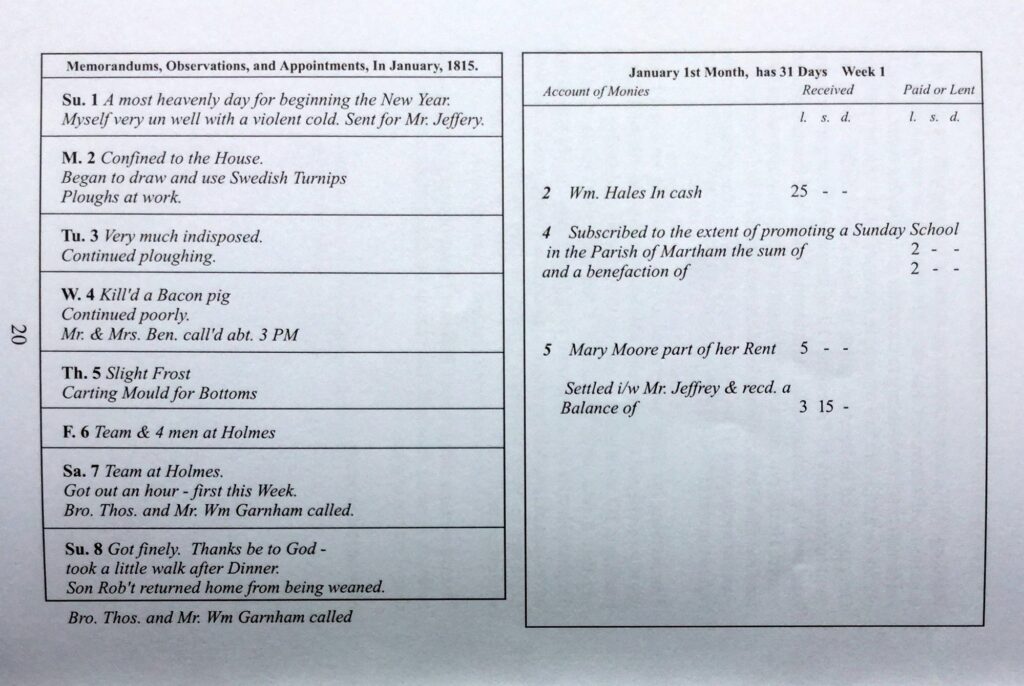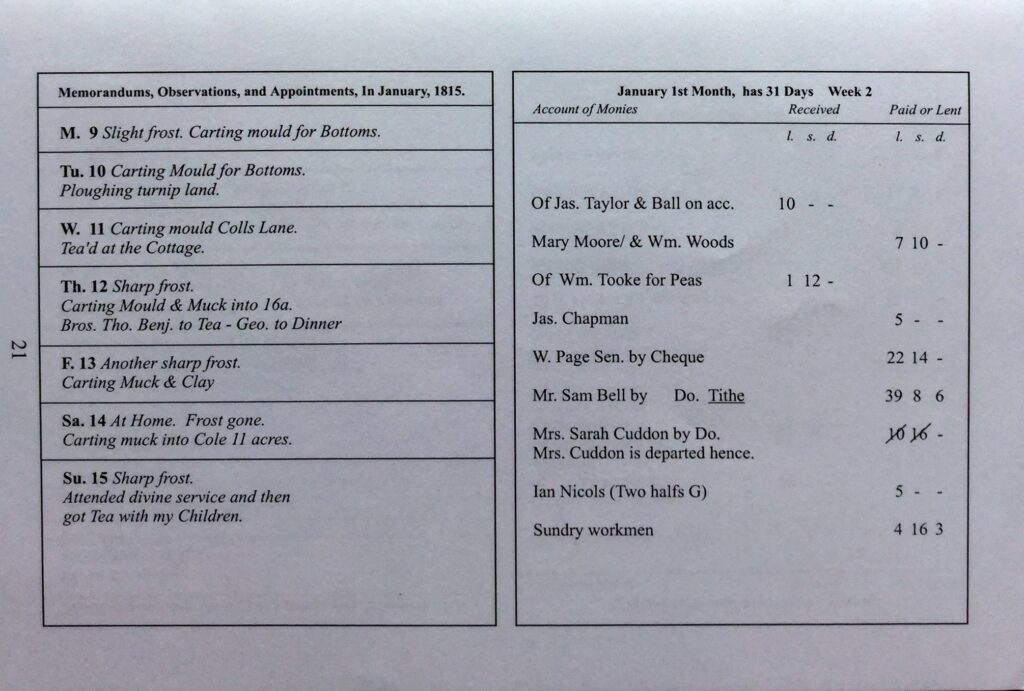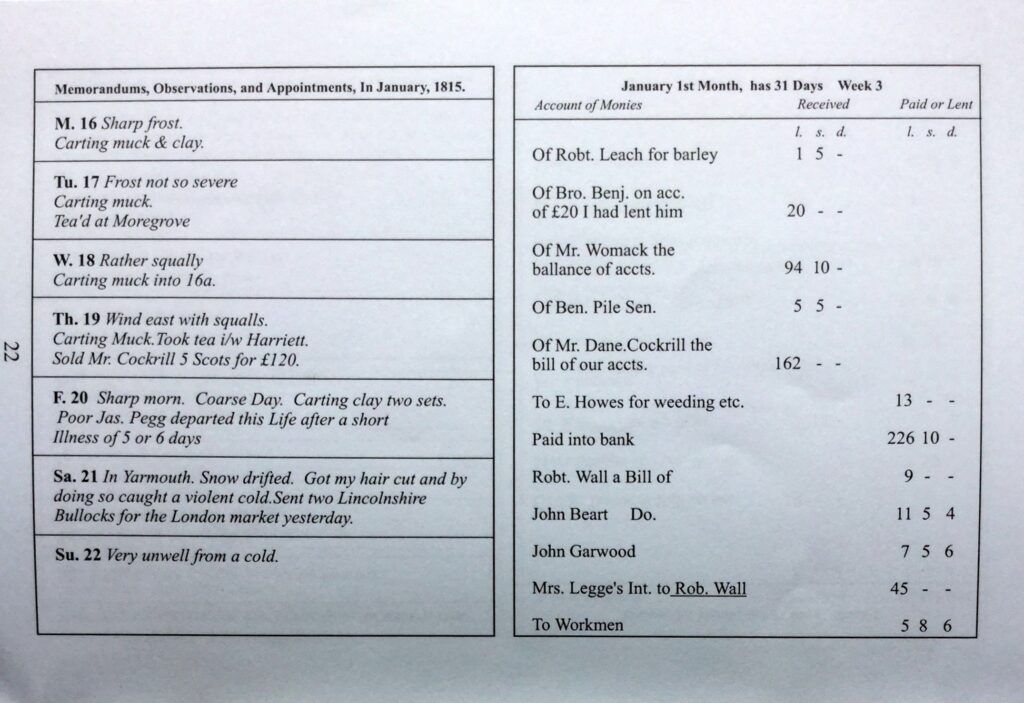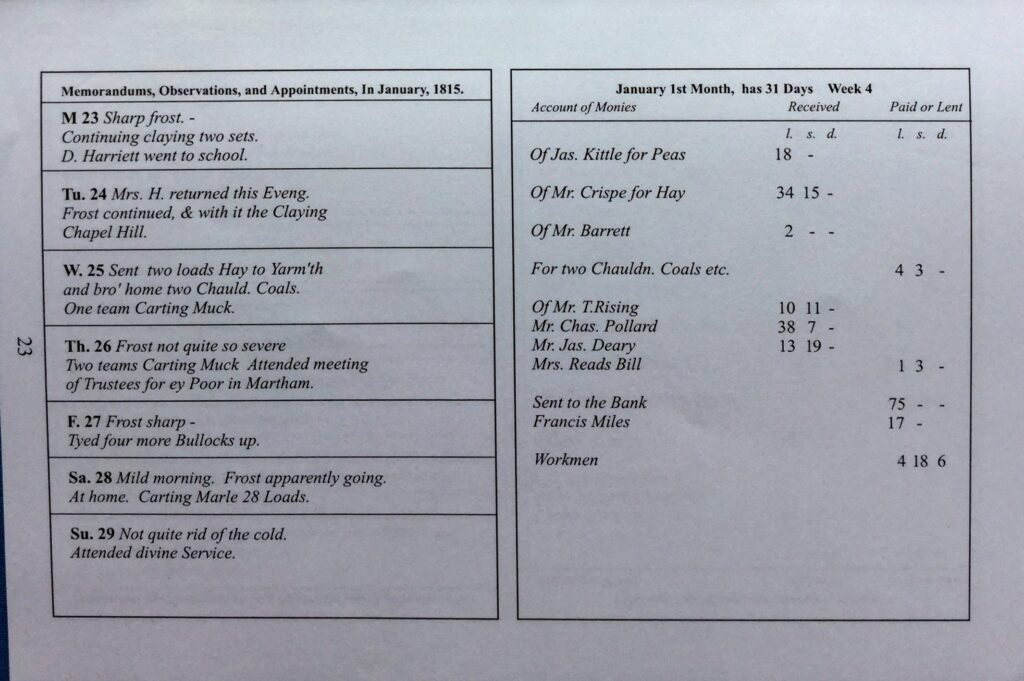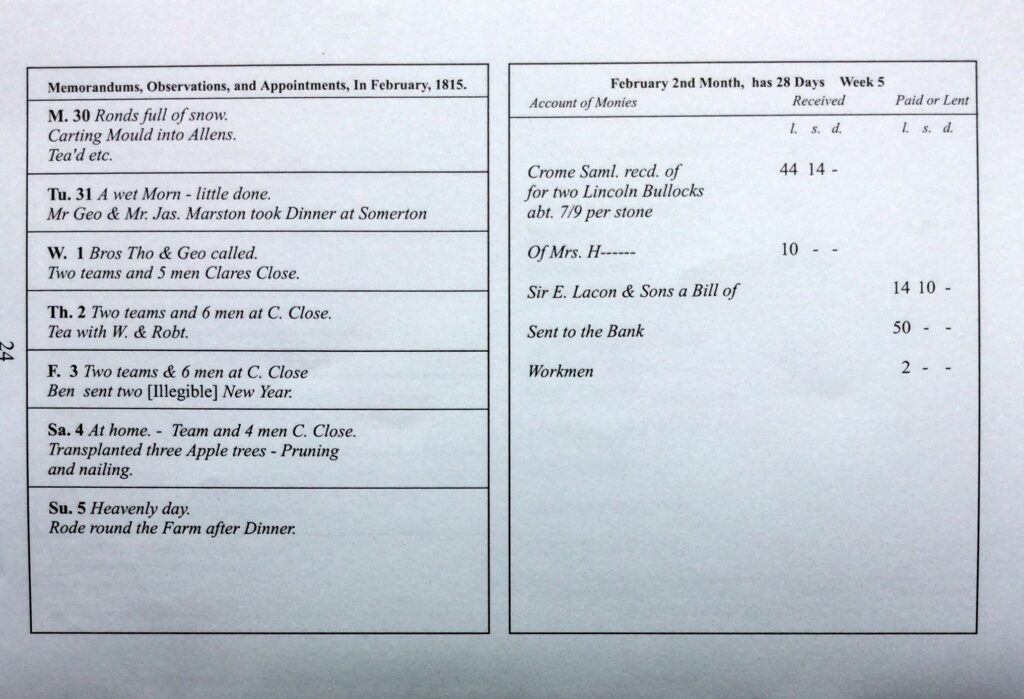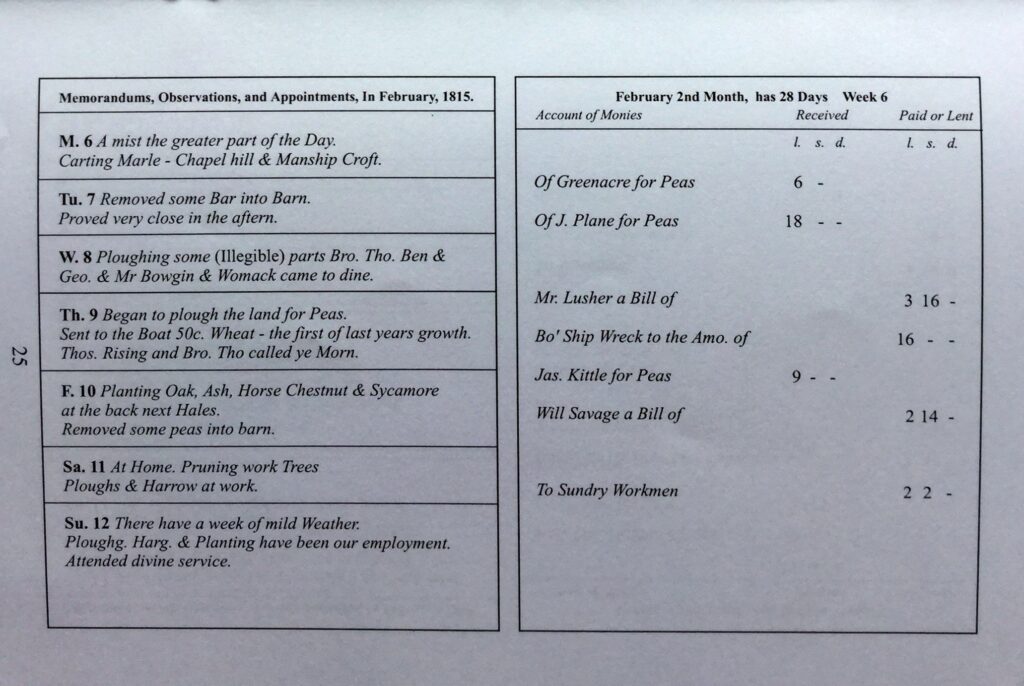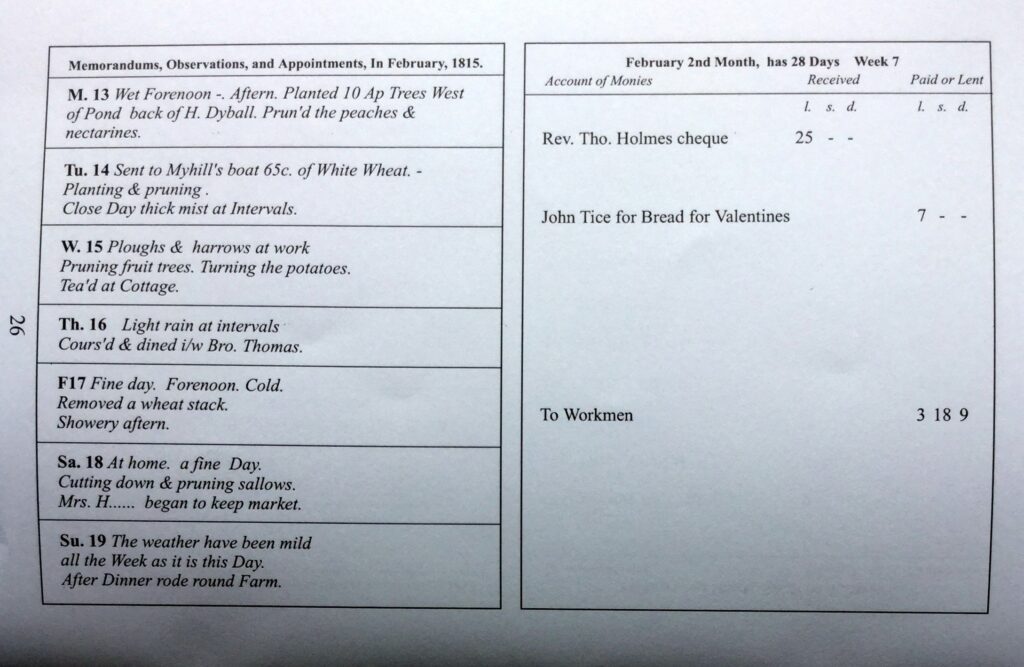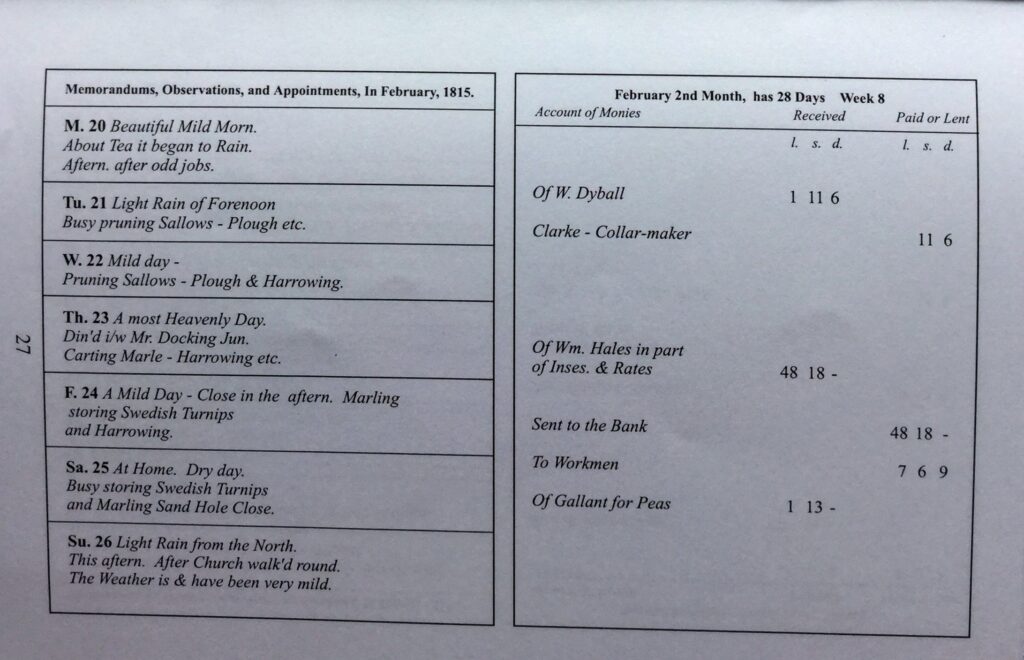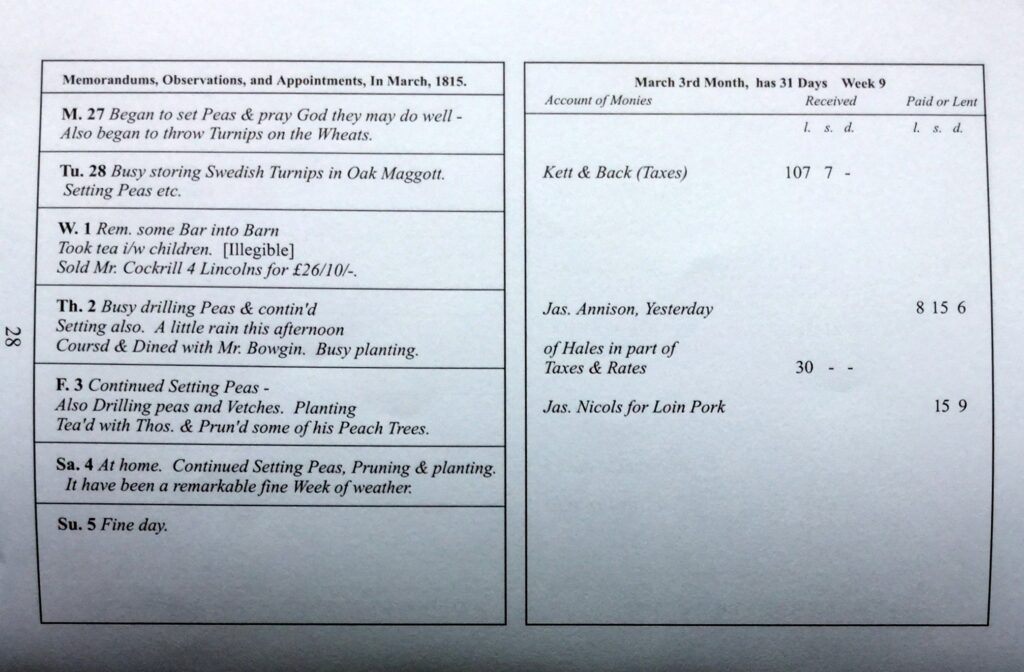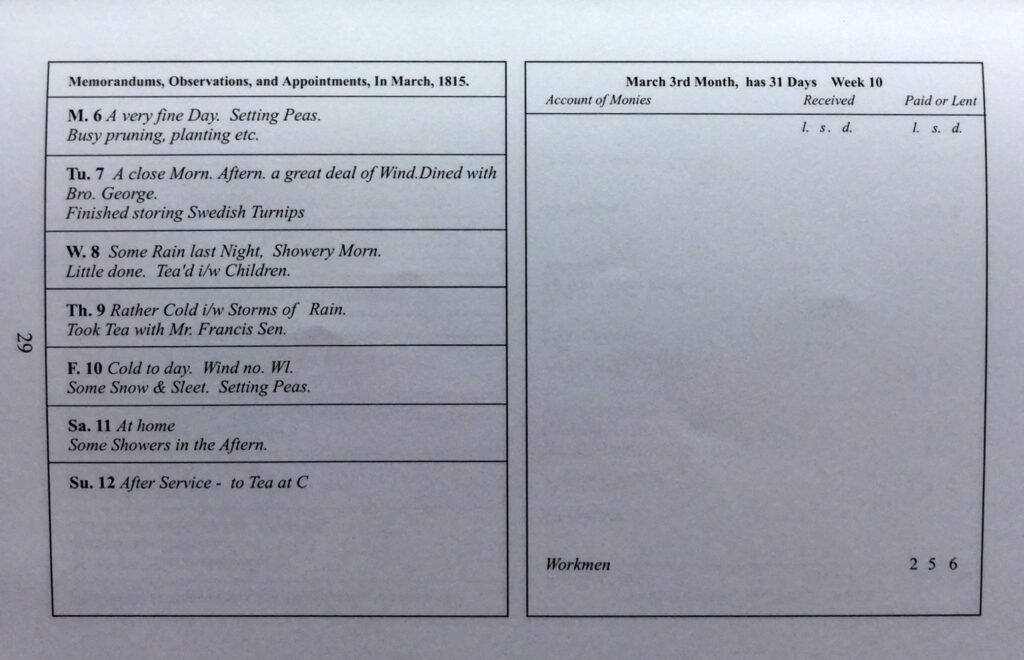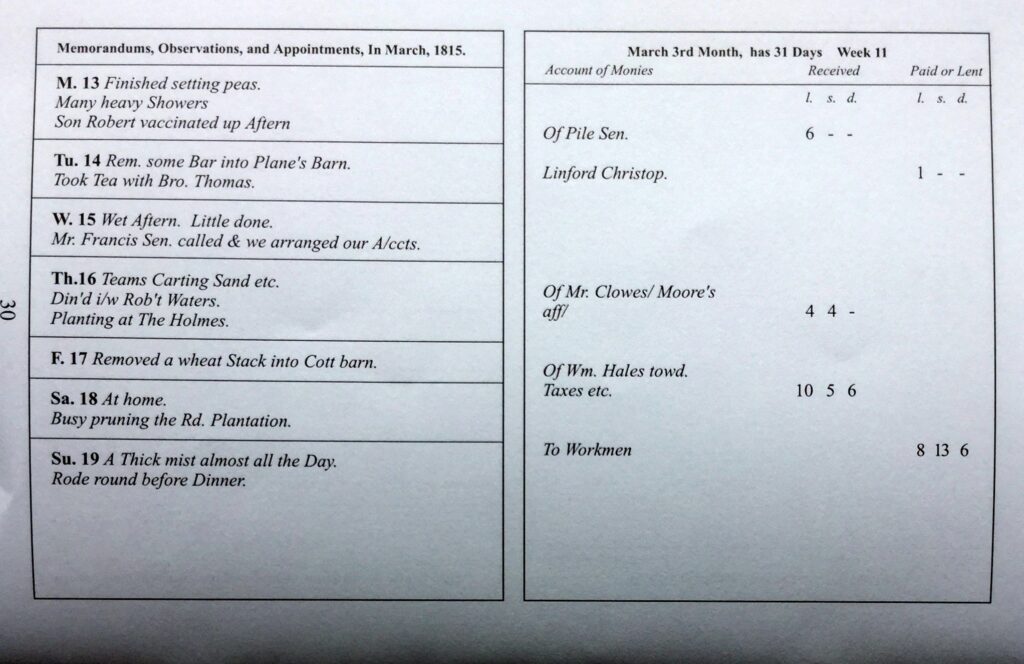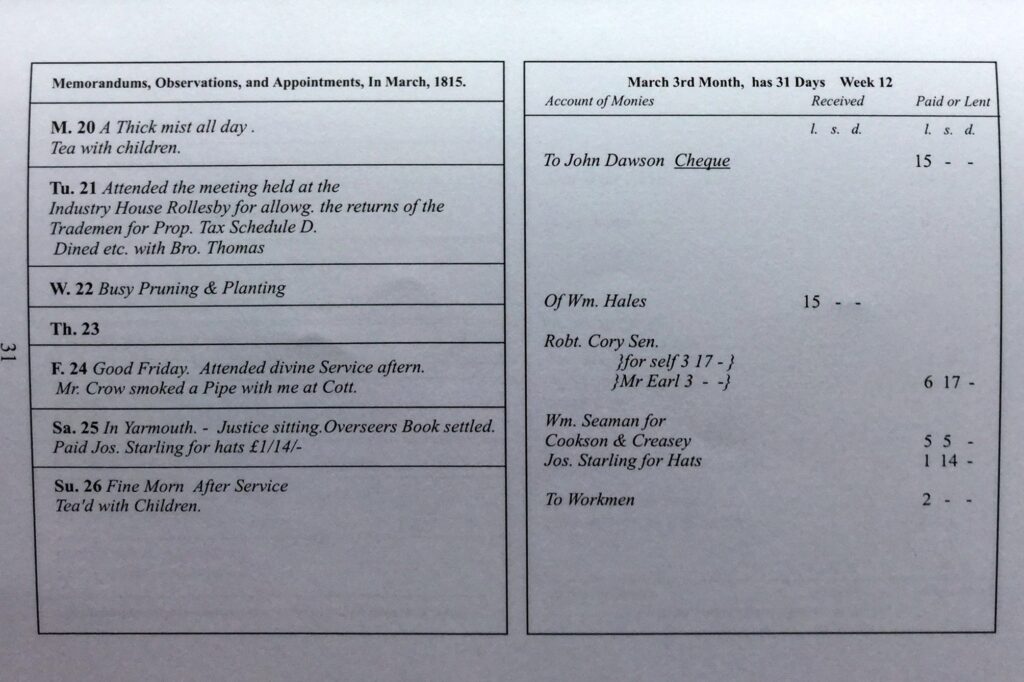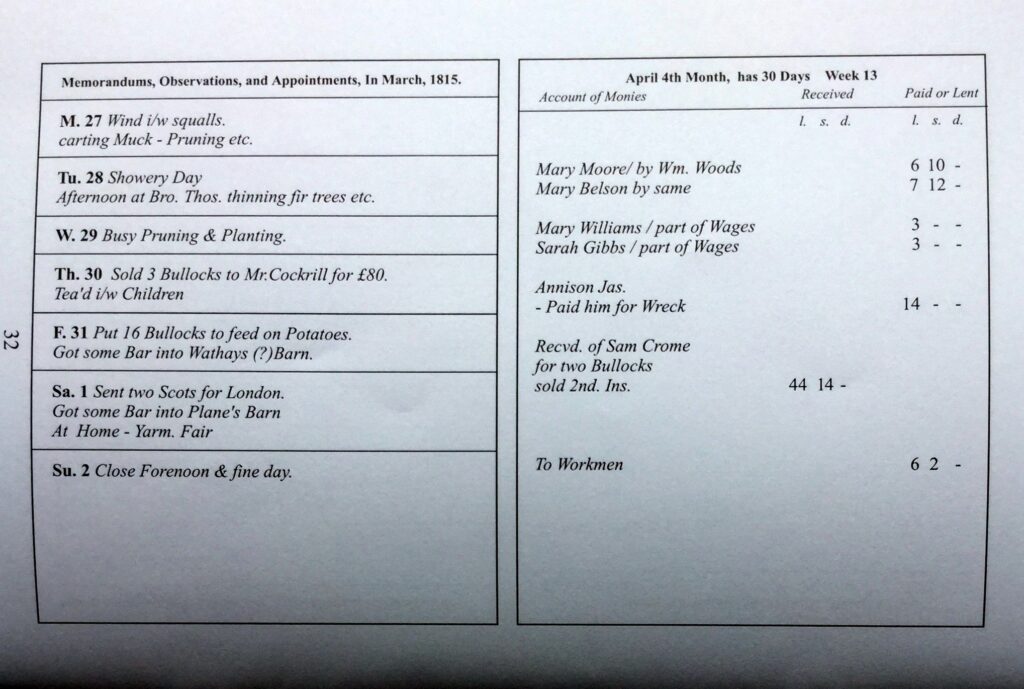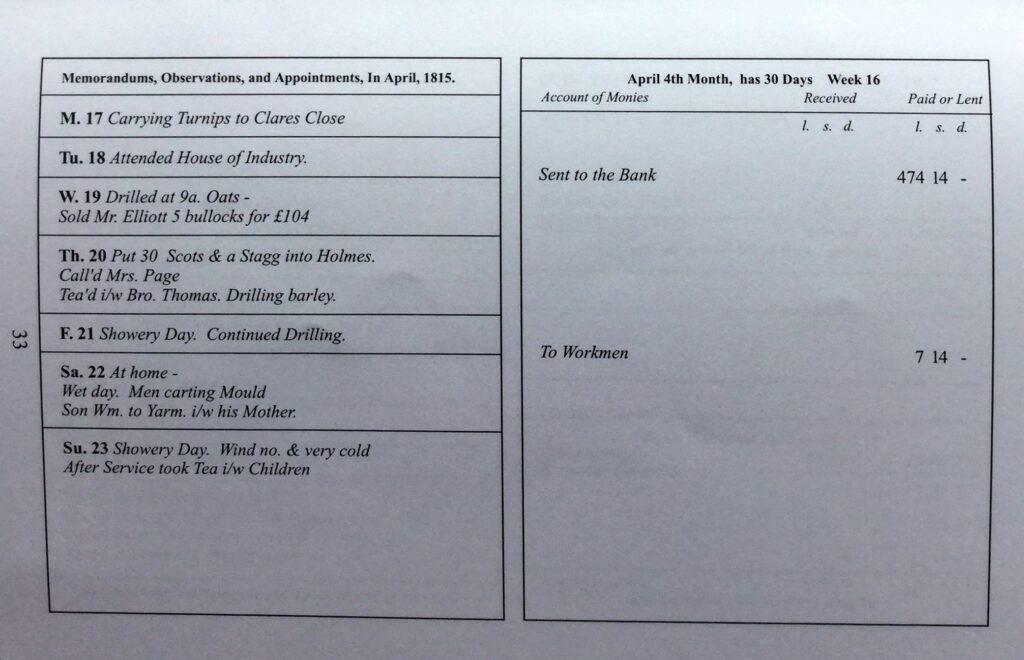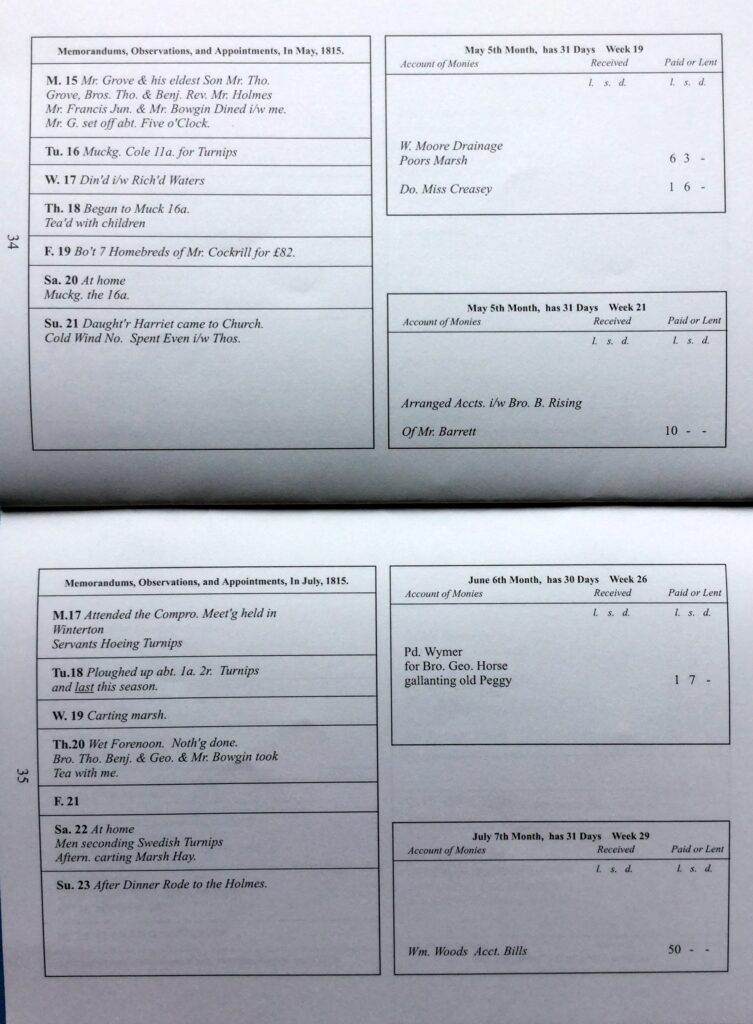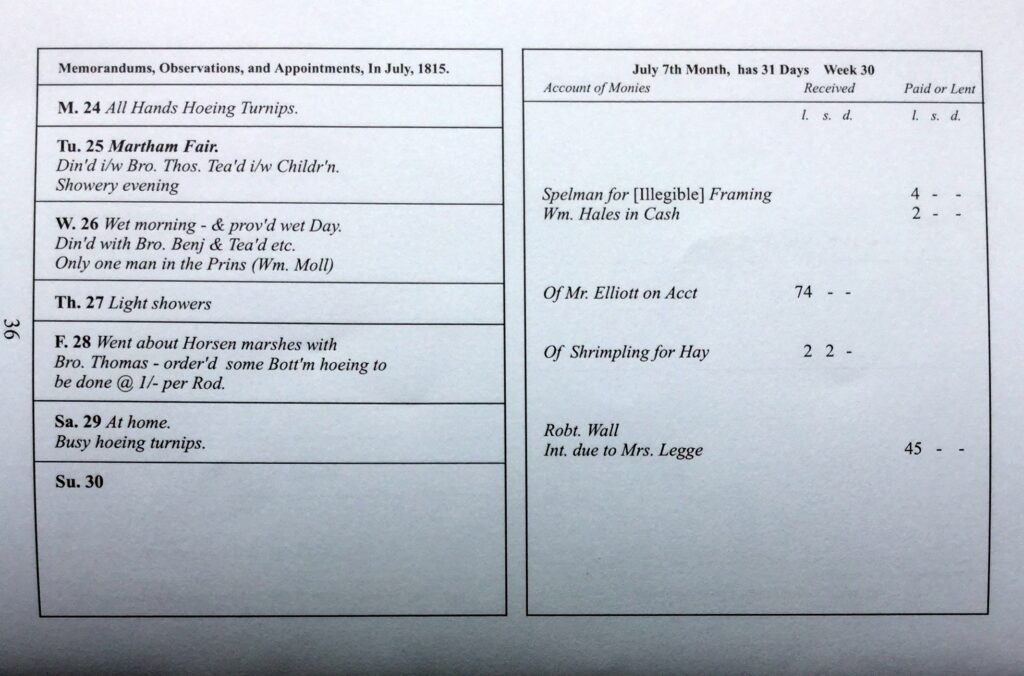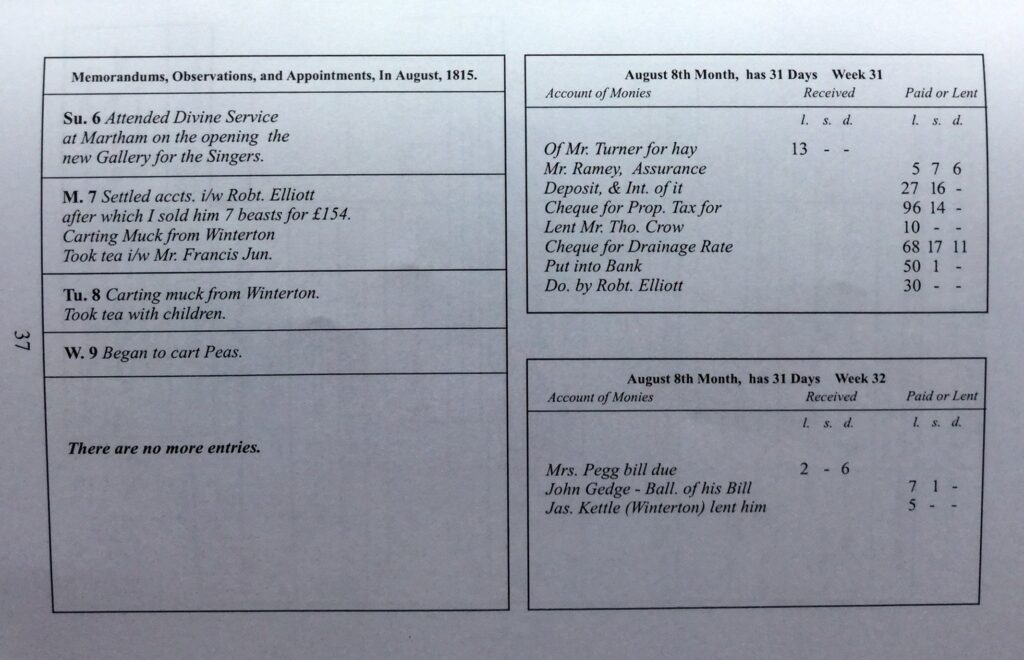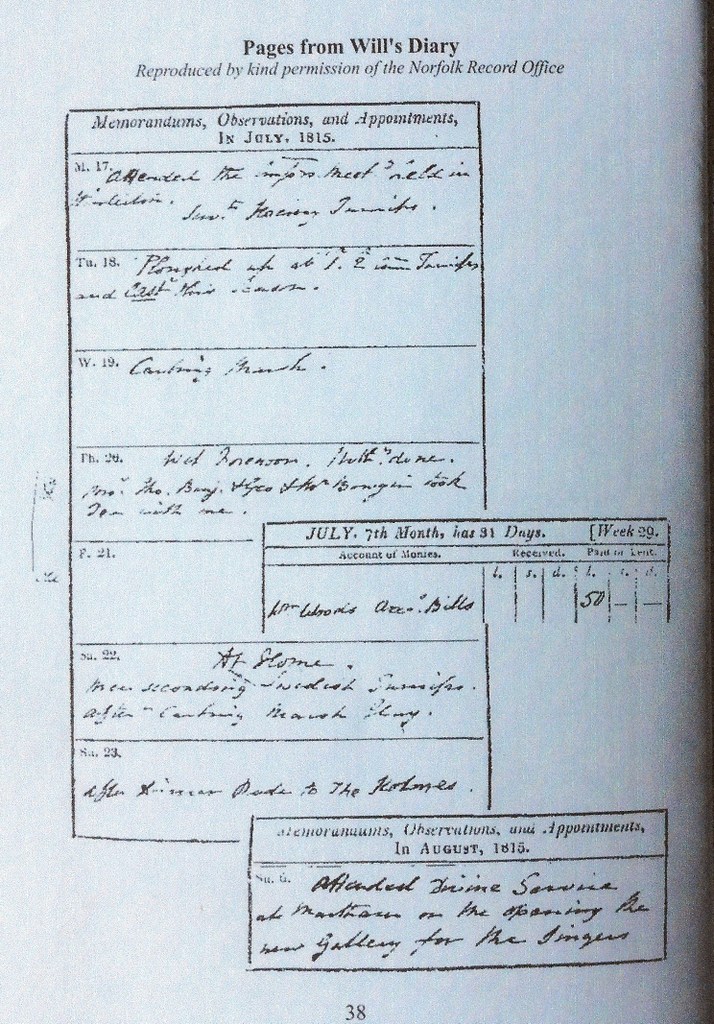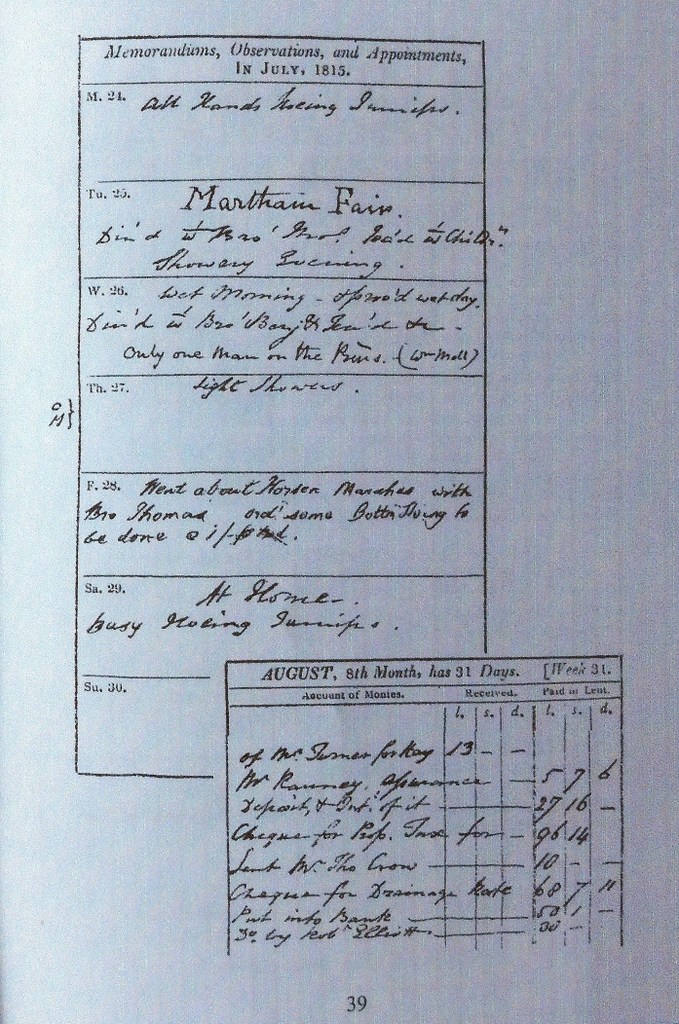The World of William Rising Gentleman Farmer of West Somerton, Norfolk
I am indebted to Ann Meakin for allowing me to publish her booklet on William Rising (1769-1846). The words are faithful to Ann’s original but the family trees and group lists have been updated since the originally publication in 2003, which is now out of print.
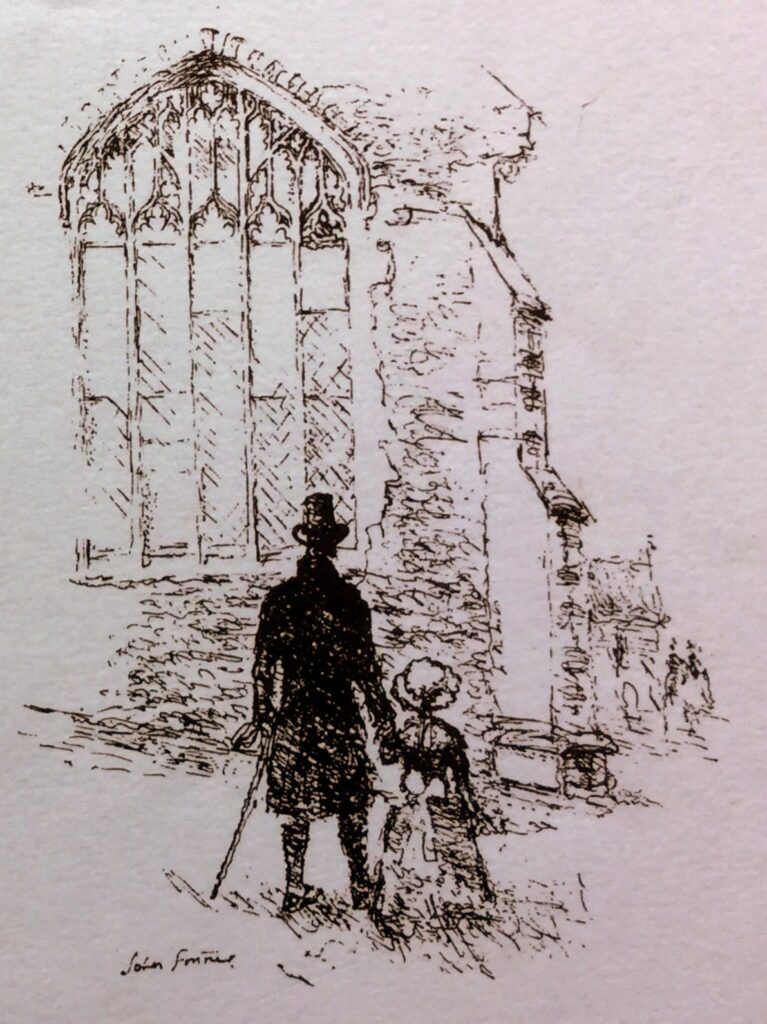
INTRODUCTION
On the north wall of the chancel of West Somerton Church you will see a memorial to William Rising Esquire of Somerton Hall who was born in 1769 and died in 1846.
His diary of 1815 was bought by the Norfolk Record Office a few years ago because it was realised that it would be of interest to local historians. It was only recently that I had the opportunity to read and study it. I knew absolutely nothing about Will Rising but became most intrigued to discover what an enigmatic and fascinating man he was and what a different world it was in East Norfolk nearly 200 years ago. I wondered how much of his world I could recreate.
Will Rising may not at present be ranked among the very famous and outstanding diarists of all time, yet his tattered fragmentary pocket diary of 1815 provides a marvellous miniature of the life of a gentleman farmer of the early nineteenth century.
I discovered that Will came from a Norfolk family who can trace their ancestry back hundreds of years, and who had been farming people of wealth and influence for many centuries. One branch lived at Martham and its members were very much in evidence in the Parish Records as churchwardens, overseers and constables. Another branch of the family lived at West Somerton and it is from this family that Will was descended.
THE DIARY
When Will kept the diary he was 44 years of age. The diary itself with the name ‘Will Rising’ written on the first page, was published by “Stevenson Matchett & Stevenson” of Market Place, Norwich and entitled “The Norfolk and Norwich Gentleman’s, Merchants and Tradesman, Farmers and Graziers complete Memorandum Book for the year of our Lord 1815 calculated for the desk or pocket – 2/6 if Bound in Red Sheep or 4/6 in Red or Rough calf.” This diary is, I think, in rough calf, but it is so worn that I cannot be sure.
The front section contains a wealth of information about county office holders, events, societies, fairs etc. The end section has information about national events including the latest Acts of Parliament likely to affect its users. In the middle are the diary pages. The Norfolk Record Office could allow me to have photocopies only of the pages that had come completely loose from the rest of the diary.
I have transcribed the diary and have recreated it to look as closely as possible like the original. A selection of the pages has been included in the latter part of this book. Where I have not been able to decipher words I have put [Illegible]. There are blank days where no entry was made. The pages for the period 3rd April to 16th April 1815 have been lost and from 28th April to 15th May 1815 there were no entries. The very last entry was on 9th August 1815. Why did it end so abruptly?
Although each day’s jottings are brief and Will used abbreviations and his own ‘shorthand’, it was relatively easy to read. He was obviously a literate man, writing fluently. In the margins he often drew a small smiley face which I think indicates that something has been of particular pleasure. See the photocopy for 20th July I have reproduced this symbol where it has been drawn on the original.
FARMING AND BUSINESS ACTIVITIES
Many of the diary entries relate to farming activities. The Parish of West Somerton lies on the northern edge of the Island of Flegg, which is bounded on the east side by the North Sea and on the others by rivers and marshes. The higher ground is of very fertile sandy loam but the lower ground was grazing marsh until drainage took place in the early nineteenth century. For administrative purposes Flegg was divided for a thousand years into the two hundreds of East and West Flegg, this arrangement existing until the local government reorganisation of the late nineteenth century. Generally the higher ground was used for arable crops and the marshes, which were subject to occasional flooding from the sea when the marram hills were breached, for common grazing until the time when the marshes were drained and enclosure took place.
At Somerton, the Enclosure Award was made in 1811. At the time of Will’s diary in 1815, the marshes were still in the process of changing because of the drainage dykes which had been created. Also, the local people were probably still adjusting to the new methods of farming their own plots of the land instead of using the common grazing land. William Rising was allotted 24 parcels of land under the Enclosure Award. When he referred to the ‘Holmes’ it was the enclosed area which was formerly marsh. The copy of a portion of Faden’s Map of Norfolk of 1797, see below, shows where the marshland was before drainage took place.
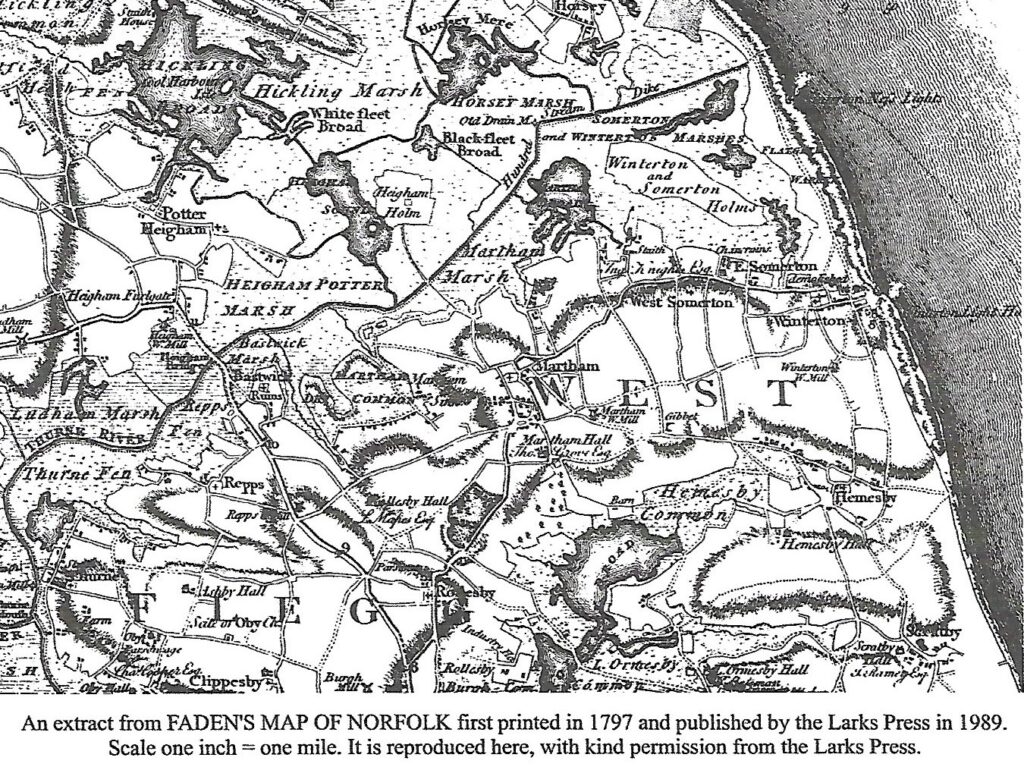
In order to gain an insight into some of the farming terms used and to discover where some of the fields, that Will referred to were situated, I went to talk to Frank Starling who, from the 1930s, was farming at Somerton Holmes with his father. He was able to tell me the names of all the fields that he had farmed. Many of them had fascinating names e.g., Dirty Bush, Long Spots, Miller’s Marsh, Clare’s Close, Rabbits, Smugglers, Kings, Corby’s Roast, Meres Field, Horse Piece. Imagine my delight when I studied the Commutation of Tithes document for West Somerton dated 1840 and discovered that the field names then were exactly the same as those used by Frank Starling and his father a hundred years later. Those fields must have been named by Will Rising when they were created from marshland and awarded to him at the Enclosure in 1811.
Since before the Norman Conquest everyone had been required to pay tithes to the church, usually one tenth of their harvest. As time went by this system became unworkable and caused much disagreement. Therefore many people preferred to make a money payment. Eventually an Act of Parliament was passed in 1836 requiring a money payment to be called a ‘rent-charge’ from everyone. It took time before this Act could be implemented everywhere and for West Somerton the Agreement for Commutation of Tithes was dated 2nd December 1840. At that time William Rising farmed more than 115 acres for which he was required to pay in future a rent-charge of £38 14s 4d. In January 1815 Will recorded in his diary, paying £39 8s 6d in Tithe, so it seems that he had not been paying ungenerously. His land at Somerton extended from The Hundred Stream which was the northern boundary of his land almost to where ‘Gibbet’ is shown on Faden’s Map, in the south. The eastern boundary was Collis Lane (called Colls Lane in the diary) and a line running northwards from the end of that, and the western boundary was towards the parish boundary with Martham. The sketch map below shows the approximate extent of the land he held.
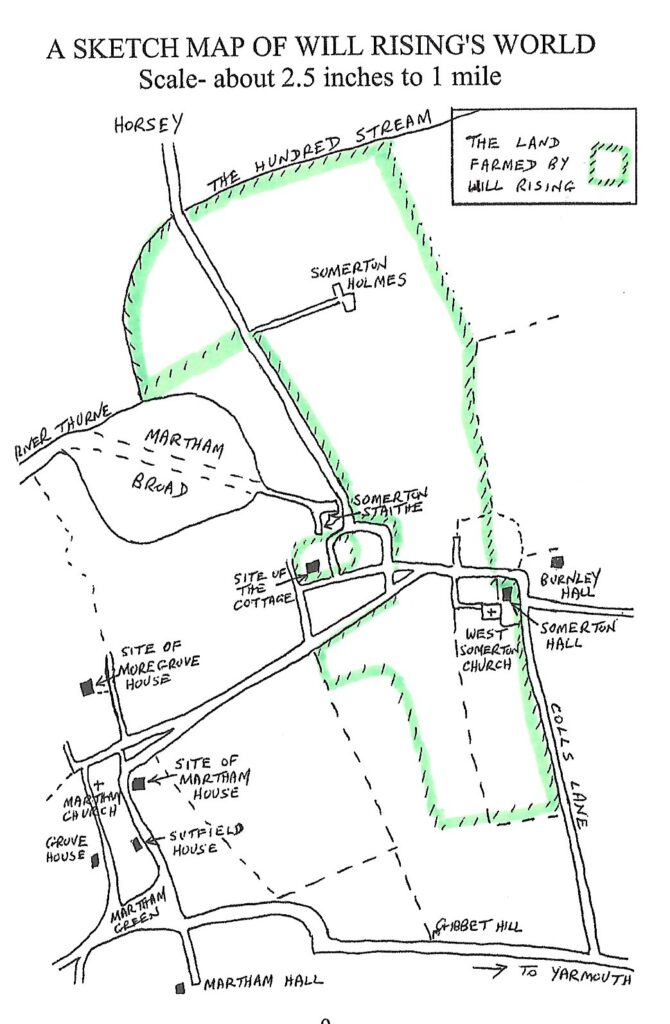
From the diary entries it is impossible to tell how prosperous Will was, but the amount of money that he handled was enormous.
Will grew a wide range of crops; Swedish and yellow turnips, peas, vetches, oats, barley, white wheat and hay. Swedish and yellow turnips could be kept in a huge pile for winter use and would not be damaged by frost. The turnips were a useful crop because they were in the ground for such a short time, but they were labour intensive. They were ‘seconded’ i.e., hoed twice to cut out the surplus plants if several were growing in one place. At the end of July and into early August it was a matter of urgency to get the hoeing done and indoor servants were employed in that as well as those who were normally worked outdoors.
Vetches would be used for cattle feed. White wheat was suitable for making into bread flour. Will related how when the wheat had been cut it was stacked on a ‘stand’, a platform on top of mushroom-shaped staddle stones so that vermin could not reach the grain. At ‘haysill’ (the hay harvest) when the hay was dry and ready for stacking the wagon would be piled extremely high and it would be a brave man who would be willing to stay on top of it ‘in the Prins’! Will told how William Moll was prepared to do this. He will go down in history for his bravado!
The most profitable enterprise seemed to be cattle for local markets and for London. Will bought and sold them in small numbers through local cattle dealers who must have collected them and driven them away themselves. Will did not mention more than once taking cattle to market himself. The Lincoln Red seemed to be the favoured breed but he also had Scottish cattle. He fed young bullocks and ‘staggs’ (animals castrated when they were more mature) on potatoes and sometimes ‘tied them up’ so that they could not exercise and would therefore put on weight more quickly.
He had numerous horses which were used in teams of four or six to draw carts, wagons and ploughs. He also had his own horses for riding. Will did not mention having any sheep and it is probable that he did not keep any. They were not an important part of the farming economy of the Flegg area at that time. He must have kept pigs because he mentioned killing one for bacon, although he also bought pork
In the grounds of Somerton Hall there is an area with a high wall on the north and east sides. This is possibly where Will grew the peaches, nectarines and apples mentioned in his diary. These would have been for home consumption.
The grain he sold was transported from Somerton Staithe and marl came in by wherry. In the days before the railways were built transport by the rivers of Norfolk was vitally important. In the Broadland area of East Norfolk the great sailing wherries with their broad shallow hulls and huge black sails were skillfully sailed or quanted by the wherrymen along the narrow winding rivers, carrying an enormous range of cargoes. At each parish staithe there would have been tremendous activity almost every day while cargoes were loaded from wherries onto wagons to go to nearby farms or unloaded. Somerton Staithe would have been no exception. Another commodity that came by boat was coal. This was bought by the cauldron which was twenty-five and a half hundredweights (cwts.) or 36 heaped bushels. A brick building which used to be a coalhouse stood beside Somerton Staithe until it was demolished about 30 years ago. The marl that was brought probably came from the central area of Norfolk. It was used to line ditches and drains because it would let very little water through. This was very important as the new drains on the fields that had been enclosed were still not totally efficient.
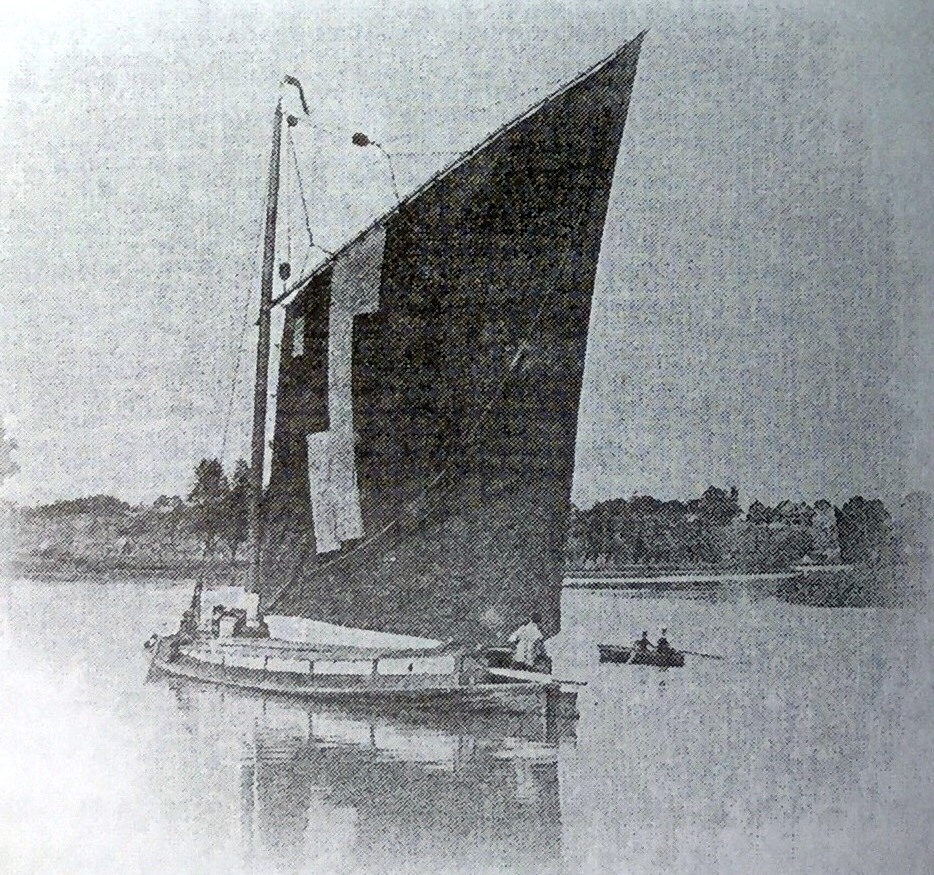
The grain he sold was transported from Somerton Staithe and marl came in by wherry. In the days before the railways were built transport by the rivers of Norfolk was vitally important. In the Broadland area of East Norfolk the great sailing wherries with their broad shallow hulls and huge black sails were skillfully sailed or quanted by the wherrymen along the narrow winding rivers, carrying an enormous range of cargoes. At each parish staithe there would have been tremendous activity almost every day while cargoes were loaded from wherries onto wagons to go to nearby farms or unloaded. Somerton Staithe would have been no exception. Another commodity that came by boat was coal. This was bought by the cauldron which was twenty-five and a half hundredweights (cwts.) or 36 heaped bushels. A brick building which used to be a coalhouse stood beside Somerton Staithe until it was demolished about 30 years ago. The marl that was brought probably came from the central area of Norfolk. It was used to line ditches and drains because it would let very little water through. This was very important as the new drains on the fields that had been enclosed were still not totally efficient.
Will mentioned carting mould, muck and clay. Mould was earth that was being moved. Muck was farmyard manure which was taken to fertilise the fields. It would be left in heaps about eight yards apart – a convenient distance for ‘setting out’, that is spreading it on the land manually. Clay, was earth that was suitable for making bricks.
Will employed several workmen but some on a very casual basis judging by the varying amounts he paid in wages.
Shipwrecks from the local representative of The Admiralty, were bought by Will. Wrecks were invaluable for recycling the timbers as building materials because of the shortage of woodland in the Flegg area. (Simon and Sue Peasley who are the present owners of Somerton Hall have discovered that much of the timber in their roof and elsewhere in the house obviously came from ships’ timbers including a mast-knee. Somerton Hall is a very ancient house that has been updated and extended many times over the centuries.) The bolts holding ships’ timbers together could be made into horseshoes. (This was still happening in the 1920s and 1930s, Frank Starling told me.)
‘The Cottage’ is frequently mentioned by Will in the diary. Perhaps it was a place that he liked to escape to; certainly all sorts of things seemed to happen there! (Archie Cator, who has lived at Somerton almost all his life, remembers being carried on his father’s shoulders as a tiny child to witness the blaze when the house which stood there went up in flames in 1917.) The Grange now stands on the site.
PEOPLE MENTIONED IN THE DIARY
Mr. Jeffrey who came when Will was unwell, was a surgeon who lived in Martham.
Mr. William Garnham was a Martham farmer.
James Pegg who died so suddenly was a Somerton man who had married Lucy Annison in 1806 and was probably much younger than Will.
The Reverend Thomas Holmes was the curate in charge of Martham and Somerton at that time.
William Hales was a Somerton farmer who lived near the staithe and was the father of Robert Hales, the Norfolk Giant, who is buried in West Somerton Churchyard
Mr Bowgin lived at Martham Hall and had married a Somerton girl. He was probably the largest land owner locally and Lord of the Manor of West Somerton Butley
Mr Grove became owner of Martham Hall when the Bowgins left.
Moses Linford from whom Will bought bricks had a large brick making business at Martham and was a pillar of the first Martham Baptist Chapel.
William Woods lived at Martham and was the highly skilled wood-
worker who made the Singers Gallery in the tower of Martham Church.
Mr. Womack lived at Somerton.
Mr. Myhill, the owner of the wherry, lived at Martham.
WILL’S SERVICE TO THE COMMUNITY
Following in the Rising family tradition, Will’s service to the community began at a young age when he first went to live at Martham. The Martham Churchwardens’ Account Book reveals that from Easter 1790 until Easter 1791 he was appointed to be one of the overseers and from Easter 1796 until Easter 1798 he was one of the churchwardens. When he returned to live at Martham at the end of his life he became one of the churchwardens at Easter 1843 and continued in office until his death.
The Churchwardens’ and Overseers’ Accounts for West Somerton do not appear to have survived. It is therefore not possible to know whether the occupant of Somerton Hall was usually the Churchwarden and Overseer. At the time of the Enclosure Award of 1811, William Rising was the only Churchwarden of Somerton and was allotted land to hold for the parish while he held that office.
In his diary Will recorded visits to the House of Industry. This was at Rollesby (see Faden’s Map) and was the ‘Workhouse’ which was opened in 1777 to care for the poor of all the Flegg Parishes of which West Somerton was one. On 25th March 1815 he went to Yarmouth to take the Overseers’ Account Book to be shown to the Justices. He must therefore have been an Overseer at that time.
Will recorded how he attended the Courts of the manors of Martham and West Somerton Butley when they were held. I wondered whether the Somerton Court was held in his house or in the nearby church. They were the only large buildings in the parish.
In his diary Will recorded that he attended the church service regularly every fortnight. This is a fair indication that a service was not held every week. At that time there was no resident vicar at Martham or West Somerton and both villages were served by curates who were in post for relatively short periods of time before moving on.
Although in 1815 Will lived at West Somerton, he seemed to have a great interest in Martham and generously donated money there. When the Singers Gallery was constructed in 1815 in Martham Church, the Martham Churchwardens paid £50 to William Woods for the cost of building it. In his diary Will also records about that time, paying £50 to W. Woods. Did he contribute half the cost of the gallery I wondered?
In his will, which he made in 1845, and is 21 pages in length, he left money to be held in trust to provide £5 each year in interest to be shared between five widows of West Somerton, five widows of Martham, the Bell Ringers of Martham and the Singers of West Somerton. Nowadays this does not sound a great deal of money but the amount invested to provide that amount of interest would have been over £100. This was in addition to leaving a considerable amount to his family and perhaps ironically, £2 to his brother Robert to buy a mourning ring! Will also expressed a wish to be buried in the chancel of West Somerton Church ‘with my ancestors’ and this wish was granted.
WILL’S FAMILY
Will was the second son of Robert Rising of Somerton and Ann Manship of Martham who were married in 1768. The memorial to them is on the south wall of the chancel of West Somerton Church. A study of it is worthwhile for its very florid language. They had fourteen children, eleven of whom grew to adulthood and nine married. They were distant cousins of the Risings who lived at Martham, having common ancestors in the seventeenth century. Why Robert, the eldest son went to live at Horsey Hall is a matter for conjecture. From the Martham Parish Records I discovered that Will went to live at Moregrove House, Martham about 1790 and farmed there when William Creasey (a distant relative) retired and went to live in Yarmouth. As far as I can gather, Will returned to Somerton in about 1796 or 1797, perhaps because of the frailty of his parents who both died in 1797. He then stayed there until he moved to live at Martham House in his old age and his son William took over the West Somerton property.
I wondered where Will and his brothers and sisters would have been educated. There was the Charity School at Martham where the sons of those who could pay were educated, and where about a dozen boys were taught in that era. Might they have been educated at home or might the boys have gone to school in Yarmouth or the Paston School at North Walsham? Will was certainly well grounded in the three ‘Rs’. (Yarmouth Grammar School was not functioning at that time but there was a Charity School. The Paston School was founded in 1606 to educate boys from a vast area of East Norfolk including the hundreds of East and West Flegg. It was known then as Sir William Paston’s Free School for Boys).
Will was obviously very fond of the company of his brothers and brothers-in-law and mentioned them frequently in his diary. He was also very fond of his own children and recorded the obviously valued times he spent with them, but, why was there no mention of his wife? In spite of having three treasured children he appeared not to be married but nevertheless had an unconventional relationship with their mother whom he referred to as ‘Mrs H’. Her name was Elizabeth Howes. She seemed to play an important role in the household management – going to ‘keep market’ – and yet he paid her 13s. on one occasion for doing weeding. I discovered that she was very much younger than he was and possibly first went to Somerton Hall as a domestic servant.
William and Elizabeth’s first child, Harriet, born in 1811, was baptised at Sea Palling where Elizabeth’s parents were living at the time. William, the second child was born and baptised at West Somerton. The entry in the Somerton Parish Register of 1812 states
“William Rising Howes son ( ) of Elizabeth Howes of this parish was born on Thursday 24th September 1812 & baptised on Sunday 11th October by R. Spurgeon Curate.” The words between the brackets were erased as though there had been an objection to the words ‘base born’ which had probably been written there. The baptism of Robert Rising is recorded on 6th February 1814 – the son of William Rising and Elizabeth. His surname is given as Howes. Each of the children was mentioned in the diary. It seems that Robert was not living at home until he was nearly a year old and weaned. Interestingly he was vaccinated later in the year. This would have been against smallpox. Vaccination became widely practised from the beginning of the nineteenth century following Edward Jenner’s discovery of its effectiveness.
William and Elizabeth were married eventually in West Somerton Church on 27th May 1841 by which time Will had reached the age of 71 and they had six children. William’s ‘condition’ at the time of this marriage was stated in the Marriage Register as ‘widower’ and Elizabeth’s as ‘spinster’. Elizabeth was not illiterate. She signed her name in the Marriage Register. So, who was William’s former wife? What happened to her? In spite of searching through numerous parish registers I have not yet discovered anything about her. The mystery remains! (Before 1857, divorce for any reason was exceptionally rare and only obtained by an Act of Parliament which was very costly. This was not a course of action likely to be taken even by a comparatively wealthy gentlemen farmer.)
THE FAMILY OF ROBERT AND ANN RISING OF SOMERTON HALL

Robert Rising (1) was born in 1732 at West Somerton. He married Ann Manship, the daughter of William Richard Manship & Susanna Sutten on 11th February 1768 at St Mary’s Church, West Somerton by license. Ann was born about 1741 at West Somerton. She died on 18th June 1797 at West Somerton. Robert died on 24th July 1797 at West Somerton. Robert & Ann had the following children:-
1.1. Robert Rising (2) was born in 1768 at West Somerton. He married Mary Preston, the daughter of Isaac & Mary Preston on 17th November 1800 at St Nicholas Church, Great Yarmouth. They lived at Horsey Hall. Robert was an army captain. Mary was born in about 1776 at Lowerstoft, Suffolk. They both died at Horsey Hall; Robert on 26th June 1841 and Mary in 1862.

1.2 William Rising was born in 1769 at West Somerton. He married (1) Mary Ann Page on 30th October 1792 at Ludham, Norfolk by license. William was a bachelor, Mary a spinster. The witnesses were John Page and Mary Rising – his sister. Mary died on 28th April 1841. William then married (2) Elizabeth Howes, the daughter of Richard Howes & Ann Neave on 27th May 1841 at St Mary the Virgin, West Somerton. Elizabeth was born in 1789 at Potter Heigham, Norfolk and died on 26th April 1868 at Great Yarmouth and is buried at West Somerton. William died in 1846 at West Somerton and is buried in the chancel of West Somerton Church.
1.3 Stephen Rising was probably born in about 1770 at West Somerton Hall and died in 1834 at Horning but there is some doubt about these records.
1.4 Tilney Rising was born in 1770 at West Somerton Hall. He married Margaret Bidwell on 20th April 1790 at Exminster, Devon. They did not have any children. Margaret was born in 1770 in Exmouth, Devon. Tilney died in 1819 in Norway.
1.5 Mary Rising was born in 1773 at West Somerton. She married Thomas Francis the son of Thomas Francis & Elizabeth Proctor on 9th December 1794 at St Mary’s Church, West Somerton by license. Thomas Francis was born in 1771 at Martham and died there on 30th March 1820. Mary died on 23rd June 1844 at Martham. They lived at West End Cottage which has since become Grange Farm.
1.6 Edward Rising was born in about 1773 but nothing more is known about him. It is likely that he died in infancy.
1.7 Thomas Sutfield Rising was born in 1774 at West Somerton. He lived at Sutfield House, Martham. He never married and died in 1855 at Martham and is buried at St Mary the Virgin graveyard.
1.8 Benjamin Rising was born in 1775 at West Somerton Hall. He married (1) Sarah Sowels on 22nd November 1804 at St Mary the Virgin, Martham. They do not appear to have had any children. Sarah was born in about 1780 and died on 20th February 1824 at Martham. Benjamin then married (2) Mary Clementina Garnham the daughter of Richard Garnham & Mary Cubit on 15th March 1827 at St Mary the Virgin, Martham. Mary was born in 1782 at Martham and died on 24th November 1832 at Moregrove Farm, Damgate, Martham. They did not have any children. Benjamin died on 17th March 1835 at Martham.
1.9 John Rising was born in 1776 at West Somerton. He married a lady called Mary in about 1800 but nothing more is known about her. John was an Army Captain and died in 1809 in Arras Prison, Hautes-Pyrenees, Midi-Pyrenees, France. There is no record of any children for the couple.
1.10 Anne Rising was born in 1777 at West Somerton. She married Robins Purdy the son of Robert Purdy & Jane Creasey on 22nd November 1804 at St Mary the Virgin, Martham. Robins was born on 8th October 1780 in Norwich. They lived at Grove House, Martham. Robins died in May 1842 at Martham. Anne died in 1844 at Martham. Anne & Robins had eleven children between 1806 and 1818.
1.11 George Rising was born in 1779 at West Somerton. He married Mary Beart on 14th January 1808 at Hemsby. They lived at Cess Farm, Martham. Mary was born in about 1784 at Gorleston. George died on 25th April 1859 at Martham and was buried at Great Yarmouth.
1.12 Charles Rising was born in 1781 and died in 1783 probably at West Somerton.
1.13 Rebecca Rising was born on 6th February 1782 at West Somerton. She married George Clabon the son of Robert & Martha Clabon on 16th February 1801 at Ashby with Oby, Norfolk. See below under Generation 2 for details of their children. George was born in about 1781. Rebecca died in 1813.
1.14 Frances Rising for which I have no other information.
THE FAMILY OF WILLIAM RISING AND ELIZABETH HOWES
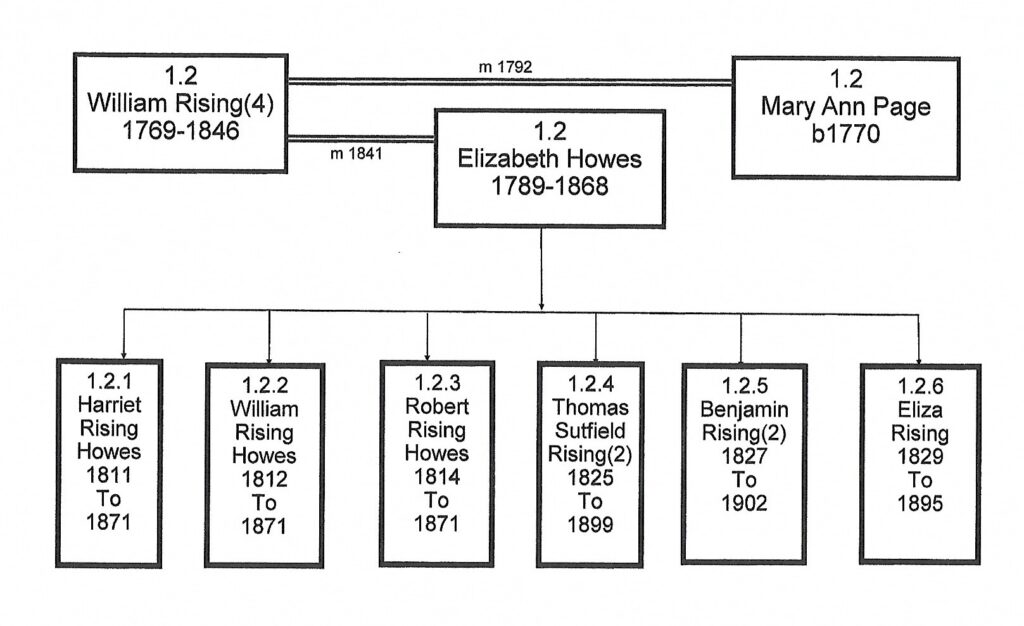
2. William Rising and Elizabeth Howes had the following children before they were married in 1841 at West Somerton.
2.1. Harriet Rising Howes who was born on 5th February 1811 at West Somerton Hall. She married William Harrison Wells the son of William Wells & Sarah Harrison on 9th May 1832 at St Mary the Virgin, West Somerton. William was born on 24th September 1805 at Martham. He died on 31st December 1874 at Stoke Holy Cross, Norwich. He was a miller. Harriet died on 16th July 1871 in Norwich.
2.2 William Rising Howes who was born on 24th September 1812 at West Somerton Hall. He married Martha Walpole the daughter of Thomas Walpole of Great Ormesby on 18th September 1860 at St Pancras, London. Martha was born between 1822-1828 at Ormesby St Margaret and died on 3rd December 1901 in Norwich. William died on 7th September 1871 at Martham.
2.3 Robert Rising Howes was born in about 1814 at West Somerton Hall. He married Mary Hawkes on 24th June 1841 at St Mary’s Church, Bryanston Square, Marylebone, London. Mary was born in about 1817 at Himley, Staffordshire. She died in 1884 at Gravesend, Kent. Robert died on 7th September 1871 at Row 59, Great Yarmouth, Norfolk.
2.4 Thomas Sutfield Rising was born in 1825 at West Somerton Hall. He was baptized at St Mary’s West Somerton on 10th September 1825. He died on 29th July 1899 at Martham where he is buried at St Mary the Virgin . He never married.
2.5 Benjamin Rising was born in 1827 at West Somerton Hall. He married Sarah James in 1862 at Newport, Shropshire. Sarah was born in about 1841 in Lillis Call, Shropshire. Benjamin was an Ensign in Her Majesty’s 76th Regiment in Zante. He died on 29th August 1902 at 19 West Parade, Rhyl, Flintshire, Wales.
2.6 Eliza Rising was born in 1829 at West Somerton Hall. She married James Bane, the son of James Bane & Esther Martin, on 4th August 1870 at St Nicholas Church, Great Yarmouth. James was born on 31st August 1822 at Reedham, Norfolk. He died in 1883 at Great Yarmouth. Eliza died in 1895 at High Road, Southtown, Great Yarmouth.
REFLECTIONS
Reading Will’s diary makes me wonder how typical he was of a middle-aged farmer of his day. He seemed to be a happy and contented man, not wanting to travel far and enjoying what seems to me to be an idyllic life of simple pleasures and country pursuits. Only once did he mention going to Norwich (19 miles away) and went infrequently to Yarmouth (10 miles away). Going to the other local markets such as Acle, Stalham and North Walsham he did not record. He did not mention anything that took place beyond his own locality. The Battle of Waterloo occurred in June 1815 yet even that was not mentioned. How aware was he of what was going on in the rest of the world? Did he ever read a newspaper?
Transcribing his diary has proved to be an exciting task and I feel greatly privileged to have been able to do it. I hope you will enjoy reading it. If I were asked to choose the most poignant entry I would say that it was when he related, I felt with great pride, that his daughter Harriet aged four went with him to church. He would not have been able to tell her the stories depicted in the mediaeval wall paintings in West Somerton Church as they were covered with whitewash until 1867.
There are many things about Will that I have not yet discovered but research is never finished! The reason for the abrupt ending of the diary I cannot explain.
May he rest in peace.
EXTRACTS FROM THE ACTUAL DIARY
